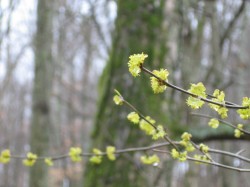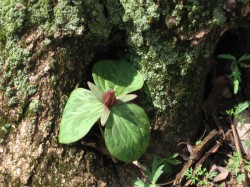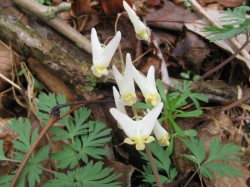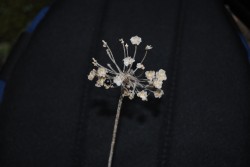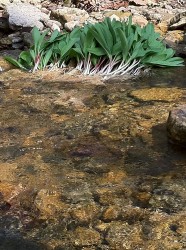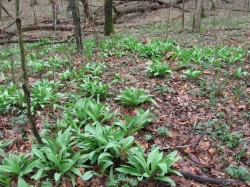 It’s that time of year again. Time to pull on the waterproof hiking boots, throw the garden fork over your shoulder, and head for the woods: ramp (Allium tricoccum) hunting. I’m not sure why I always refer to it as ‘hunting’–I know where they are, and we take care to insure they will be there year after year. This is not a trip to be enjoyed in a hurry with your next task in mind. I like to walk slowly, soaking it all in. Just about every step is rewarded with new life as the wildflowers and ferns push through the rich wet leaves.
It’s that time of year again. Time to pull on the waterproof hiking boots, throw the garden fork over your shoulder, and head for the woods: ramp (Allium tricoccum) hunting. I’m not sure why I always refer to it as ‘hunting’–I know where they are, and we take care to insure they will be there year after year. This is not a trip to be enjoyed in a hurry with your next task in mind. I like to walk slowly, soaking it all in. Just about every step is rewarded with new life as the wildflowers and ferns push through the rich wet leaves.
There are limits to this hunt. One is time, dictated by Mother Nature, as she only allows the ramps to display themselves for a short window. The leaves begin to show in late March-April, with signs of their senescence timed with the increase in temperature and day length. I believe the ramp harvest will be short this season as temperatures have been unseasonably high.
The ramp bulbs grow in clumps clustered together in moist, well-drained, wooded sites, rich in organic matter. They are often found under woody species such as Beech, Buckeye, and Spice Bush. If your woody ID is lacking but you are wild about wildflowers, you will find them sharing space with bloodroot, cut-leaf toothwort, Dutchman’s breeches, trillium, and trout lily.
It is extremely important–to me–that we work diligently to insure future generations will have the good fortune to experience the ramp hunt. When harvesting, we never take an entire clump. Instead, when a clump is dug, 1/3 or less is carefully separated for harvest and the remaining clump is replanted. The ramp flowers in June after the foliage has died back. The seed matures on this flower stalk and drops to the ground to begin formation of a new clump. According to Jackie Greenfield and Jeanine Davis in their publication “Cultivation of Ramps,” the ramp seed can take up to 18 months to germinate. If we were to remove the entire clump, there would be no flower, and therefore there would be no seed, and this would mean no ramps for the future.
The smell is intoxicating, consistently making my mouth water and my stomach growl. When harvesting and washing, I like to pull a root or two to chew. Often referred to as wild garlic or wood leek, the flavor is sharp and strong. It is easy to understand their popularity. To get the ramp flavor you don’t have to harvest the entire plant. The leaves are edible and just as flavorful as the bulb. Another harvest method is to cut the foliage and leave the bulb. This method of harvest insures seed production and future ramp production.
The USDA Natural Resources Conservation Service website list ramps as a species of special concern in Maine, Rhode Island, and Tennessee. In Tennessee they are also listed as commercially exploited. We are doing our part to keep Kentucky off of this list.

